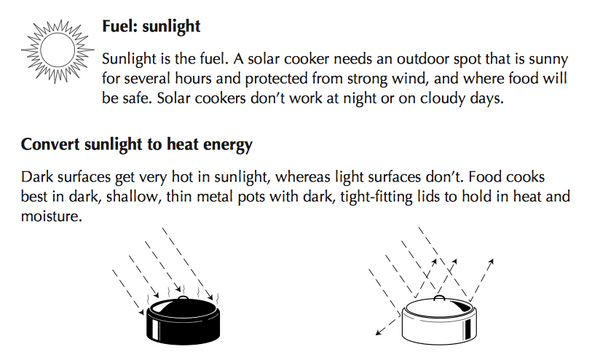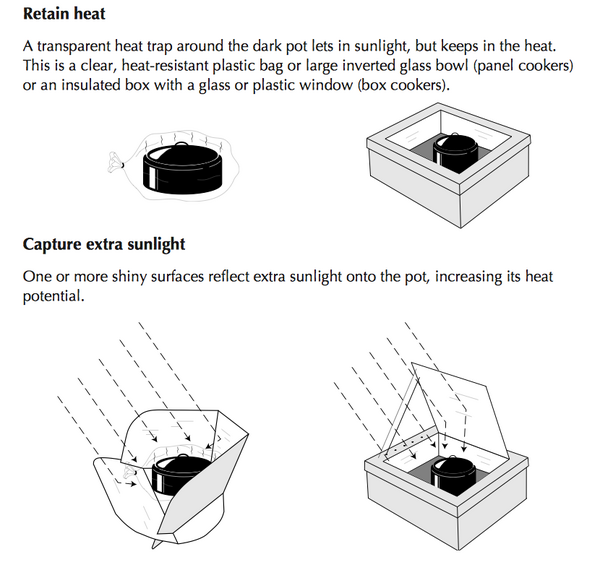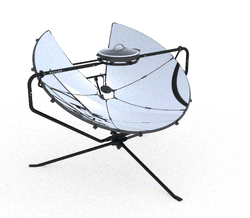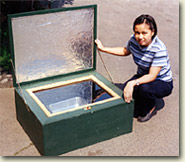Paul Hedrick (talk | contribs) mNo edit summary Tag: sourceedit |
Paul Hedrick (talk | contribs) m (→See Also) Tag: sourceedit |
||
| Line 56: | Line 56: | ||
==See Also== |
==See Also== |
||
*[[Introduction to solar cooking]] |
*[[Introduction to solar cooking]] |
||
| − | *[[Principles of Solar Box Cooker Design]] - '' |
+ | *[[Principles of Solar Box Cooker Design]] - ''Mark Aalfs'' |
*[http://images2.wikia.nocookie.net/__cb20080215180446/solarcooking/images/3/3a/Pejack-on-solar-cooker-technology.pdf The Technology of Solar Cooking] - ''[[Ed Pejack]]'' |
*[http://images2.wikia.nocookie.net/__cb20080215180446/solarcooking/images/3/3a/Pejack-on-solar-cooker-technology.pdf The Technology of Solar Cooking] - ''[[Ed Pejack]]'' |
||
*[[Compendium of solar cooker designs]] |
*[[Compendium of solar cooker designs]] |
||
Revision as of 19:30, 10 June 2015
|
Last edited: 10 June 2015
|
How do solar cookers work?
Most solar cookers work on the basic principle: Sunlight is converted to heat energy, that is retained for cooking.
Below is the basic science for solar panel cookers and solar box cookers. The other main variety of cookers are called parabolic solar cookers. They typically require more frequent reorientation to the sun, but will cook more quickly at higher temperatures. They also have the ability to fry foods.
A solar cooker needs an outdoor spot that is sunny for several hours and protected from strong wind, and where food will be safe. Solar cookers don't work at night or on cloudy days, though during the best months for cooking, many foods can be cooked under intermittent clouds or a light haze, as long as food is put out early and there is definitely more sun than not overall.
- Parabolic solar cookers use a bowl shaped reflector to focus the light more directly onto the cook pot, usually from below, and typically do not require a greenhouse enclosure to retain the heat. They also have the ability to fry and broil foods.

SolSource is an example of a parabolic solar cooker shown with cookware. The light is focussed at the bottom of the cook pot.
Converting sunlight to heat energy
At its simplest, the sunlight-to-heat conversion occurs when photons (particles of light) moving around within light waves interact with molecules moving around in a substance. The rays emitted by the sun have a lot of energy in them. When they strike matter, whether solid or liquid, all of this energy causes the molecules in that matter to vibrate. They get excited and start jumping around. This activity generates heat.
Dark surfaces get very hot in sunlight, whereas light surfaces don't. While food cooks best in dark, shallow, thin metal pots with dark, tight-fitting lids, there are many other containers that can also be used in a solar cooker.
- Main article: Pots
Retaining heat
A transparent heat trap around the dark pot lets in the sunlight, and keeps the heat that is produced from escaping. This is a clear, heat-resistant plastic bag or large inverted glass bowl (in panel cookers) or an insulated box with a glass or plastic window (in box cookers).
Light passes through the plastic bag or glass cover as a relatively short wavelength. Heat is reflected back as a longer wavelength, and does not easily pass back through the clear enclosure. This explains why cars left in the sun, especially those with black interiors, will slowly become hotter and hotter, even on days with low air temperatures.
Parabolic solar cookers typically do not require a heat trap, as the light from the reflector is tightly focused on the cook pot. They cook at higher temperatures, but require more frequent reorientation with the sun than box or panel cookers.
- Main article: Glazing
Capturing extra sunlight energy
One or more shiny surfaces reflect extra sunlight onto the pot, increasing its heat potential. Mirrors, aluminum foil, mylar, mirror-finish metals, chrome sign vinyl, and other shiny materials have all been used successfully for solar cooking, depending on the type of cooker and the environment in which it will be used.
- Main article: Reflective material
Solar cooker types
The three most common types of solar cookers are box cookers, curved concentrators (parabolics) and panel cookers. Hundreds — if not thousands — of variations on these basic types exist. Additionally, several large-scale solar cooking systems have been developed to meet the needs of institutions worldwide.
Box cookers
Box cookers cook food at moderate to high temperatures and often accommodate multiple pots, typically taking between one and three hours to cook various foods. Worldwide, they are the most widespread. There are several hundred thousand in India alone.
- Main article: Solar box cooker designs
Panel cookers
Panel cookers incorporate elements of box and parabolic concentrator cookers. They are simple and relatively inexpensive to buy or produce. Solar Cookers International's "CooKit" is the most widely used combination cooker.
- Main article: Solar panel cooker designs
Parabolic cookers
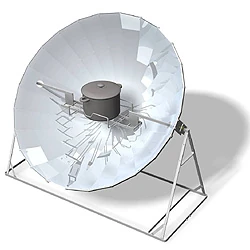
An AlSol 1.4 parabolic cooker demonstrates where the cook pot is supported to receive the focussed light from below from the reflector.
Parabolic solar cookers use a bowl shaped reflector to focus the light more directly onto the cook pot, usually from below, and typically do not require a greenhouse enclosure to retain the heat. The parabolic name refers to the shape of the curve of the reflector cross-section.
They will require more frequent reorientation to the sun, possibly every 10 minutes, but they cook food more quickly at higher temperatures compared to other solar cookers, often reaching over 200°C (400°F). They also have the ability to fry foods. Generally parabolic solar cookers will need to be attended to more than box or panel cookers to avoid possibly burning the food at the bottom of the cook pot. They are especially useful for large-scale institutional cooking.
- Main article: Parabolic solar cooker designs
See Also
- Introduction to solar cooking
- Principles of Solar Box Cooker Design - Mark Aalfs
- The Technology of Solar Cooking - Ed Pejack
- Compendium of solar cooker designs
- All solar cooker designs found on this wiki
- Why solar cook
- Where solar cook
- Health and safety
- Solar water pasteurization
- Solar calculations
- July 2006: Varieties of Solar Cooker Devices and Uses - Shyam Nandwani
External links
- Construction of Solar Cookers and Driers - Christelle Souriau & David Amelin (This is an excellent overview of solar cooking basics and simple solar cooker and dryer construction methods.)
- Parabolic Solar Cookers - Humboldt State University
- How Solar Cooking Works - HowStuffWorks
- The full text of the book The Expanding World of Solar Box Cooking - Barbara Kerr
- Evaluation of Several Original and Commonly Used Solar Cooker Designs - Dane Dormio and Steven Jones
- Rating Solar Cookers
- French: Evaluation des fours solaires

